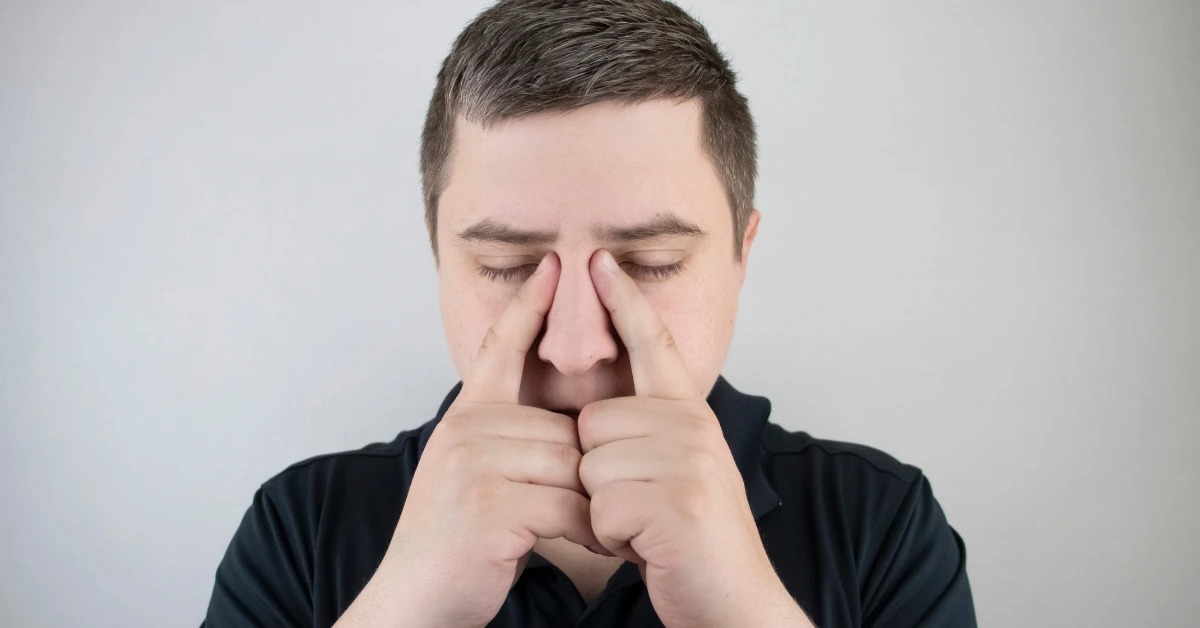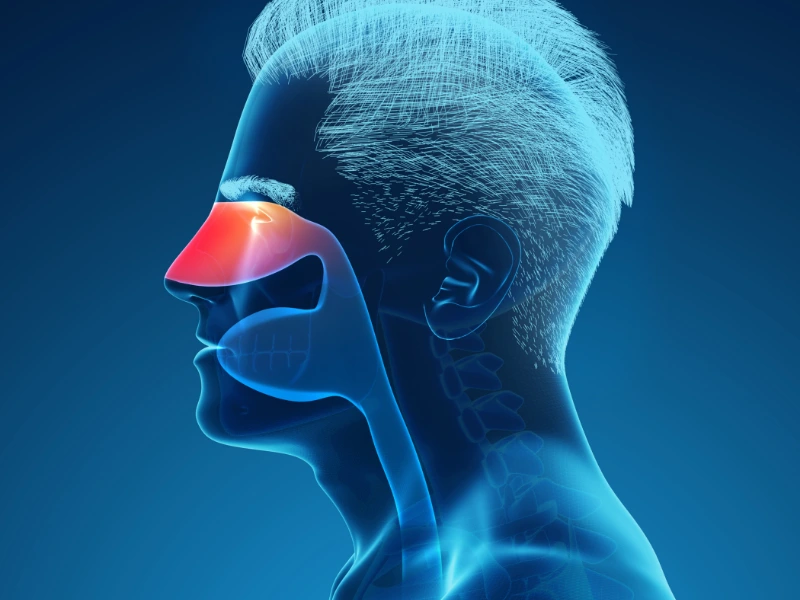
On my way home from work, I usually take the metro. As I’m standing there, someone in front of me sneezes repeatedly without covering their nose. I feel a slight irritation in my nose, but I try to ignore it, even though I know it may trigger my allergic sinusitis or even lead to a sinus infection. By the time I get home, my nose is completely stuffed, and I can’t breathe properly through it. I struggle to fall asleep, tossing and turning all night, and wake up feeling exhausted—it’s hard to shake the grogginess.
When I get to the office, I’m barely functioning. My head is pounding from lack of sleep, and my nose feels completely blocked. As I sit at my desk, I realize I can’t concentrate. Midway through the morning, my phone rings. I try to speak, but my voice is muffled, and I can barely get the words out because of my stuffy nose.
I check my trash bin, and it’s overflowing with used tissues. I’ve been constantly blowing my nose for hours, and even with an inhaler, nothing gives me relief. I can’t focus on work, and all I can think about is how miserable I feel. It’s just another day living with allergic sinusitis, and I wonder how much longer I can deal with this.
Since I had already tried all medical treatments and still experienced the same issues, I decided to explore natural options. I’m glad I found NAET. After multiple sessions, I finally felt relief—after 24 years, I can now breathe properly because NAET focused on addressing the root causes instead of just managing the symptoms.
-Kimberly Torreon , 20th August 2025
Living with Allergic Sinusitis in Dubai
When I was in the Philippines, my allergic sinusitis wasn’t triggered every day because I could avoid the usual causes. But moving to Dubai has been very challenging. The city’s extreme heat, humidity, and environmental factors make my condition worse. Most mornings, I wake up with a blocked nose. The combination of construction dust, weather, and even indoor mold from air conditioning leaves me with constant symptoms.
My warning signs are an itchy throat, watery eyes, and heavy sinuses that no amount of water or tissues can relieve. This isn’t just a health issue—it affects my daily life. I struggle to focus at work, wear a facemask during Shammal winds, and feel at risk in crowded places like the metro when someone sneezes nearby. Living in Dubai means facing these triggers all year round, which is frustrating and exhausting.

What Makes My Allergic Sinusitis Different from a Common Cold?
Many people get confused between a regular cold and allergic sinusitis because the symptoms feel so similar—stuffy nose, sneezing, and a heavy head. But over time, I noticed the differences. Unlike a cold that clears in a few days, my sinusitis symptoms lingered for weeks, sometimes months. I have a cat I adore, but I realized her fur was making my allergic sinusitis worse. There was no fever or sore throat—just constant nasal congestion and facial pressure that never went away.
Another clue was how often I felt sick. It wasn’t from catching colds repeatedly; it was my reaction to everyday triggers in Dubai. What made it clear was that allergy medicine gave me relief, while cold medicine did not. That’s when I understood this wasn’t a cold—it was allergic sinusitis, and it needed a different approach to treatment.
Why Allergic Sinusitis is a Year Round Challenge in Dubai
When I moved to Dubai, I thought I just had a weak immune system because I was always sneezing and my nose felt irritated everywhere I went. Unlike other countries where allergies come and go with the seasons, Dubai is different the triggers are everywhere. From the dry desert air to high humidity and poor indoor ventilation, something in the environment is always setting off my sinusitis.
One of my biggest challenges here is dust. It’s everywhere—from Shammal winds to heavy construction around the city, and even the buildup inside my home or office. My sinuses never get a break. Just a few minutes outside can leave me with a stuffy nose for the rest of the day. Managing allergic sinusitis in Dubai isn’t seasonal—it’s a daily struggle that requires constant effort.
Dealing with Allergic Sinusitis During Sandstorms (Shammal Winds) in Dubai
One of the worst triggers for my sinus infection is when the Shammal winds blow in. These dry northwesterly winds sweep across the Arabian Gulf region, including Dubai, especially during summer. They carry large amounts of dust and sand, and the moment I step outside, I feel it—my nose starts to itch, and my eyes begin to water. Even wearing a facemask isn’t enough to stop the irritation.
What makes it worse is that these storms can start suddenly and last for hours or even days. During the Shammal winds, I’ve had to completely change my routine: avoiding going outside as much as possible, using air purifiers at home, and doing nasal rinses to clear out any dust I might inhale. Yet even with all these precautions, I still end up with sinus infections. Living in Dubai means learning to expect sudden weather changes and preparing for them.
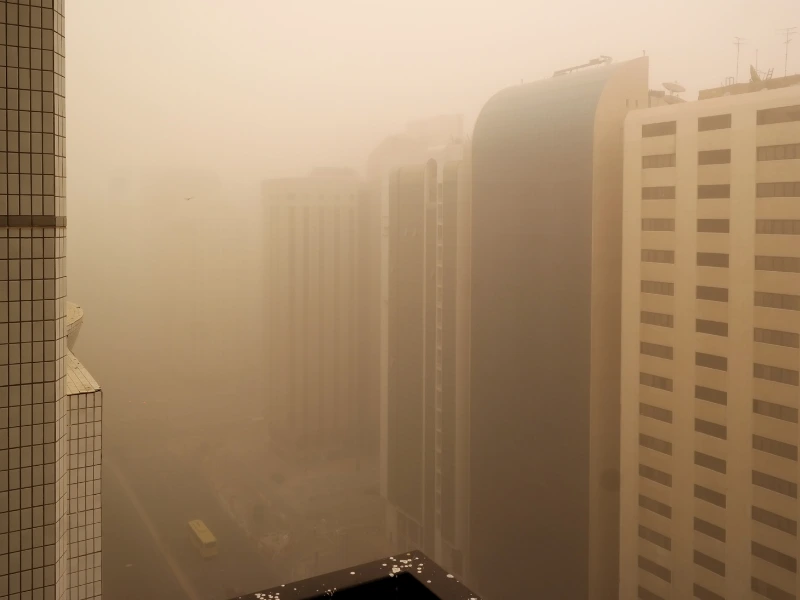
The Impact of Central AC that Affects my Allergic Sinusitis in Dubai
Central air conditioning is very common in Dubai because it can cool large spaces during the intense summer heat. Like many people, I relied on it for comfort, but I began noticing frequent nasal congestion and suspected my AC might be the cause. I later learned that central AC can have negative effects, as mold often grows inside the long ductwork—especially when there are leaks, poor airflow, high humidity, or lack of regular cleaning. Unlike window units, it’s harder to maintain.
As someone with allergic sinusitis, this was an eye-opener. I realized how important it is to ensure the air I breathe at home is clean and safe.
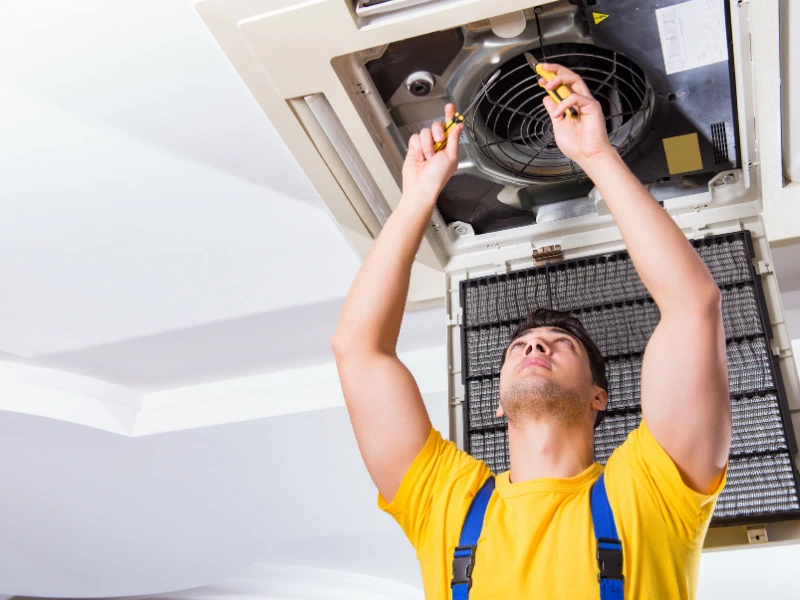
Window Type AC
When I was living in the Philippines, I used a simple window AC and never had to deal with mold. I could easily clean the filters, which kept the air fresh. Unlike central AC, window units don’t rely on long ductwork, so there’s less chance of moisture buildup, and they’re easier to maintain. I only needed to cool one room—usually my bedroom—where I could rest after a long day of work.
For anyone dealing with sinus infections, the type of AC you use matters, as it can directly affect your health.
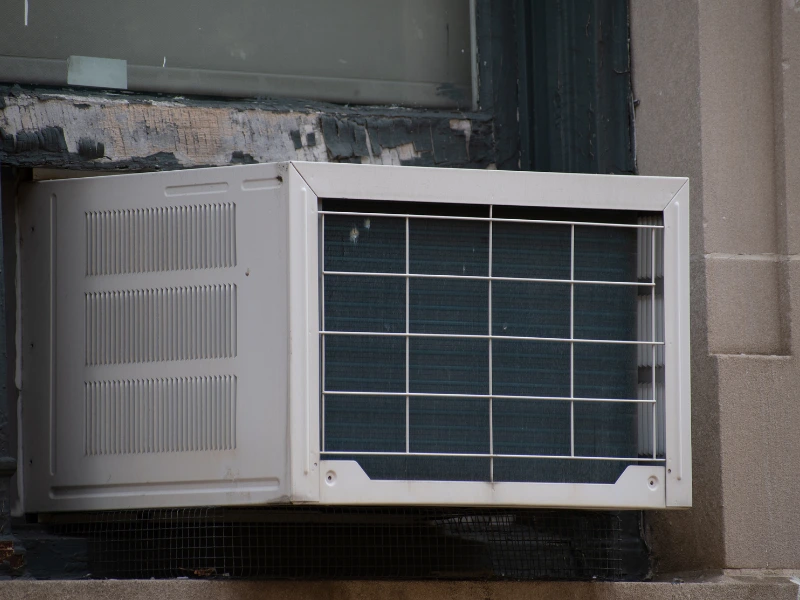
Mold in My House: A Hidden Trigger of Allergic Sinusitis
I never thought mold would be a problem in Dubai. With the hot, dry weather outside, it’s the last thing you’d expect. But I began experiencing sinus infections—blocked nose, runny nose, and facial pressure—especially when I was at home. Eventually, I discovered mold growing on the ceiling near my AC. I hadn’t noticed it right away because it was in the corner, but it had been slowly spreading due to the central air conditioning.
I also found small leaks around the AC, and even a little moisture was enough for mold to grow. Fixing leaks quickly and maintaining the AC are simple but essential steps to prevent mold and protect both our homes and our health.
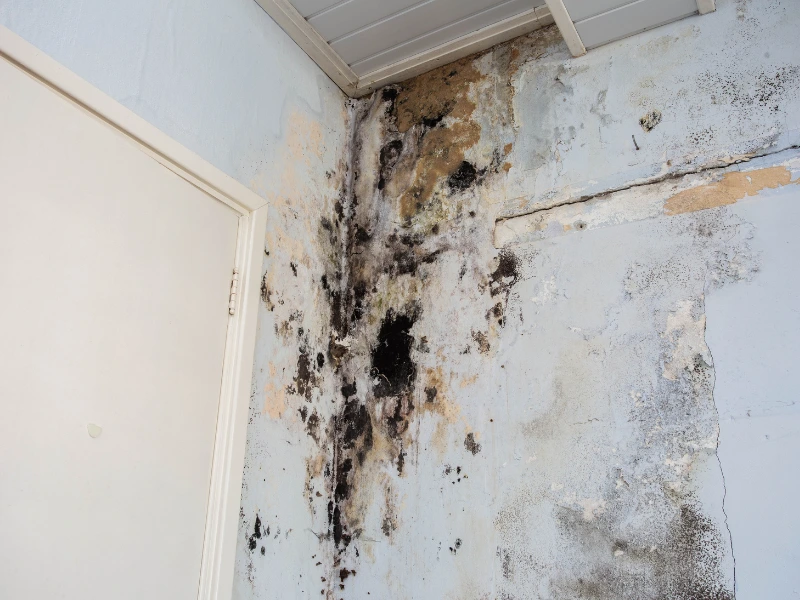
Dust Exposure: How Dubai’s Construction Sites Affect Your Sinuses
Dubai is widely known for its impressive architectural landscape, with new developments rising on almost every block. I’ve gotten used to seeing cranes everywhere. While the city’s growth is remarkable, it also has a downside I didn’t expect—constant dust in the air.
As someone with allergic sinusitis, this is a real challenge. Construction dust is hard to avoid because it lingers in the air we breathe every day. With so many open sites, trucks, and cranes digging across the city, I noticed my sinus symptoms worsened on windy days or when I passed by active construction areas. It made me realize how much the environment here contributes to my sinus infections.

When Kids Play In The Backyard, They Always Itching
We all know kids love to play outside, especially in the backyard. I often saw my neighbor’s children scratching their arms and legs. At first, I thought it was normal—maybe just heat rash from the Dubai sun or insect bites. But as I watched them playing around the plants and grass, they were always itching and sneezing.
Curious, I did some research and learned that outdoor allergens like pollen, dust, and even mold in backyard areas can trigger allergies and lead to sinus infections. That explained why the children were sneezing and itching so often. I immediately told my neighbor, and she now trims the grass regularly, keeps the backyard dry to prevent mold, and makes sure her kids shower and change clothes after playing outside to remove any allergens.

How My Perfume Contributing to My Sneeze and Allergic Sinusitis
I’ve always loved using sweet perfumes because they make me feel comfortable and confident when I smell good throughout the day. Floral, fruity, and sugary scents were my favorites. But I noticed that after applying them, I often started sneezing, and sometimes my nose became stuffy.
I later learned that perfumes contain alcohol and synthetic chemicals that can irritate sensitive nasal passages and even trigger a sinus infection. It was hard to let go of my usual scents, but to avoid triggers, I switched to milder or fragrance-free alternatives. This small change really helped me breathe more comfortably. If you’re experiencing similar symptoms, it may be worth checking your favorite perfume too.
Runny Nose at Work: Could it be Allergic Sinusitis
One of the most stressfull about living with allergic sinusitis is the nonstop runny nose, especially when I’m trying to work. Its very distracting and embarrasing. When we have a meeting I always have tissues. There are days that I coudn’t focus at all because my nose was running non stop. I thought it was just a cold but the symptoms would not go away. I realized that it was my allergic sinusitis flaring up rigger by things like mold, dust or even cleaning products in the office. Now I keep my workplace clean. These small changes helped me to manage my runny nose and sinus issues so I can focus in my work.
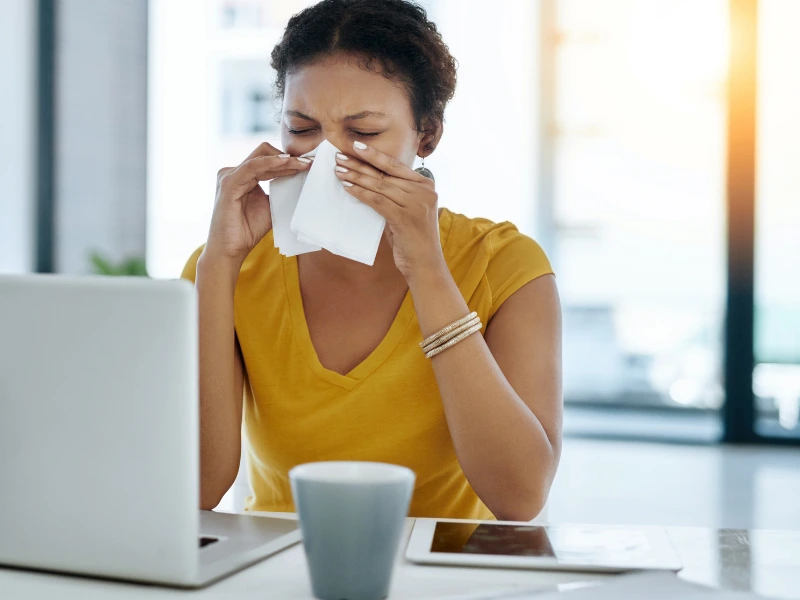
Always Blocked Nose
Having a blocked nose is so annoying—it feels like a shadow that follows me everywhere, constantly draining my energy and affecting my mood. It really disrupts my sleep. At night, I can’t breathe properly through my nose and struggle to find comfort. Even when I do manage to fall asleep, I don’t feel fully rested and wake up exhausted.
I’ve come to realize this is a recurring problem. At first, I thought it was normal to wake up tired, but as days turned into weeks and months, I understood that a sinus infection doesn’t just affect my nose—it impacts my entire well-being. Each day feels like a battle to find relief, and the cycle of blocked sinuses, poor sleep, and low energy becomes a loop that feels impossible to break.
Could Untreated Allergic Sinusitis Could Develop Into Nasal Polyps
Allergic sinusitis is a chronic inflammation of the sinuses caused by allergens such as pollen, dust mites, and mold. When left untreated, nasal polyps can develop. These are painless, soft, noncancerous growths in the lining of the nasal passages or sinuses that can block the airways, leading to breathing difficulties and constant discomfort.
In severe cases, untreated polyps can completely obstruct sinus drainage, resulting in chronic sinus infections, sleep disturbances, and even asthma. The presence of nasal polyps also worsens allergic sinusitis, with many people experiencing a complete loss of smell and taste, which greatly impacts daily life.
Some people choose to surgically remove nasal polyps; however, they often grow back. Surgery only removes the existing polyps but does not address the root cause, which is why nasal polyps tend to return.
Breathing Problems
Breathing difficulties are one of the symptoms of allergic sinusitis. When allergens enter the body, they can cause the sinuses to swell. This swelling blocks the nasal passages and increases mucus production, making it hard to breathe through the nose. Ongoing nasal congestion from allergic sinusitis can also affect sleep.
When the nasal passages are blocked, snoring becomes more common as the body struggles to get enough air through the nose. In some cases, this can even lead to sleep apnea, where breathing briefly stops during sleep. As a result, you may wake up multiple times at night, feel tired during the day, and struggle to concentrate. That’s why managing allergy symptoms is essential for getting restful, restorative sleep.
Understanding The Four Types of Sinusitis and Their Symptoms
Acute
Occurs when the lining of the sinuses becomes suddenly inflamed, usually after a viral infection such as the common cold. Symptoms may include nasal congestion, facial pain or pressure, headache, postnasal drip, and thick nasal discharge. It typically lasts up to 4 weeks and often resolves with rest, hydration, and simple treatments. However, in some cases, it can be complicated by a secondary bacterial infection.
Sub Acute
This is a longer-lasting form, where inflammation persists for 4 to 12 weeks. It may be triggered by bacterial, viral, or fungal infections, and in some cases, allergies can contribute. Symptoms are usually less intense than acute sinusitis but last longer, causing nasal obstruction, mild facial pressure, and lingering fatigue. Without proper treatment, it can progress to chronic sinusitis.
Chronic
Defined as persistent inflammation of the sinuses lasting 12 weeks or longer, even with treatment attempts. It may develop from repeated acute infections, untreated allergies, structural nasal issues (like a deviated septum), or immune system problems. Symptoms include ongoing nasal blockage, facial fullness, thick nasal discharge, postnasal drip, reduced sense of smell, and sometimes nasal polyps. It often requires a more comprehensive treatment plan and may not fully resolve without addressing the underlying causes.
Accural
Diagnosed when a person experiences four or more episodes of acute sinusitis within a year, with symptom-free periods in between. It is often triggered by repeated viral upper respiratory infections (like the common cold), untreated allergies, or environmental irritants. Each episode typically lasts less than 4 weeks but keeps coming back, causing significant discomfort and disruption to daily life.
Treatment Options for Allergic Sinusitis in Dubai
Medical Treatment
The goal of medical treatment for allergic sinusitis is to reduce inflammation, control the allergic response, and relieve symptoms.
Septoplasty is a surgical procedure to correct a deviated septum. It is usually performed by an ENT (ear, nose, and throat) surgeon under local or general anesthesia. The surgery involves straightening and repositioning the septum by removing or reshaping bone and cartilage. Its main goal is to improve airflow and allow better sinus drainage.

Nasal corticosteroid sprays work by reducing inflammation in the nasal passages and sinuses. When sprayed into the nose, the medication is absorbed by the nasal tissues, slowing down the activity of immune cells that trigger allergic reactions.
Natural and Holistic Approaches
Natural and holistic approaches to allergic sinusitis aim to address the root cause of the condition rather than just managing symptoms.
NAET (Nambudripad’s Allergy Elimination Techniques) is a non-invasive, drug-free method that focuses on treating the root cause. NAET practitioners believe that allergies result from energy imbalances in the body. During treatment, allergens are identified through muscle response testing, and the patient is then exposed to small amounts of the allergen while receiving acupressure to reprogram the body’s response.
In addition to NAET, other natural solution can help. For example, a Jal neti or saline (saltwater) nasal rinse using a neti pot or squeeze bottle can flush out mucus and irritants from the nasal passages. This helps keep the nasal cavity clean, reduce congestion, and improve breathing.
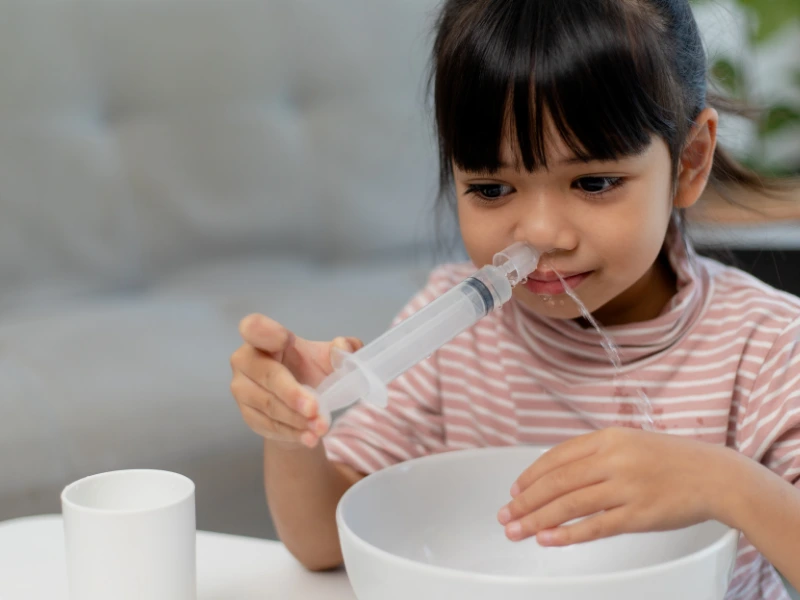
Home Care Tips to Reduce Dust and Allergens
Managing allergic sinusitis should begin at home by removing common indoor allergens such as dust mites, pet dander, mold, and pollen. One of the most effective ways is to keep the home clean and well-ventilated. Start with a regular cleaning routine: vacuum often, wash bedding and pillow covers weekly in hot water to kill dust mites, and change pillowcases frequently. Clean curtains, blinds, and window panels, as they are major dust collectors, and wipe hard surfaces with a damp cloth to trap dust instead of spreading it.
Using a humidifier can also help, as it prevents conditions that encourage mold and dust mite growth. These simple steps not only reduce allergy triggers but also lower the risk of developing a recurring sinus infection.
Connect with us through our Facebook page at www.facebook.com/NAETDubai or visit: www.naetdubai.com. You will find a wealth of information here along with an opportunity to speak confidentially through WhatsApp 056-639 0197 or Phone Call 04-420 1633.
Frequently Asks Questions (FAQ)
Early signs include itchy throat, watery eyes, sneezing, nasal congestion, and a heavy feeling in the sinuses that don’t improve even with rest or hydration.
Common triggers in Dubai include dust, sandstorms (Shammal winds), construction dust, mold from central AC units, pet dander, perfumes, pollen, and indoor allergens like dust mites.
Summer brings high humidity, poor indoor ventilation, and heavy reliance on central AC—conditions that promote mold growth. Combined with Shammal winds carrying sand and dust, sinus symptoms intensify.
Yes. Airborne irritants like construction dust, vehicle emissions, and indoor pollutants aggravate sinus inflammation and make allergic sinusitis harder to manage.
Management includes reducing exposure to allergens (dust-proofing your home, cleaning AC filters, using purifiers), nasal rinses, switching to mild or fragrance-free products, and exploring natural therapies like NAET.
Yes. Mold often grows inside central AC ductwork due to leaks or humidity. Breathing this contaminated air leads to blocked sinuses, facial pressure, and recurring sinus infections.
Effective remedies include saline nasal rinses, air purifiers, regular home cleaning to reduce dust and mold, humidifiers to balance indoor air, and switching to fragrance-free products.
NAET (Nambudripad’s Allergy Elimination Techniques) is a non-invasive, drug-free therapy that identifies and desensitizes allergens. Instead of masking symptoms, it addresses the root causes, helping long-term relief from allergic sinusitis.

